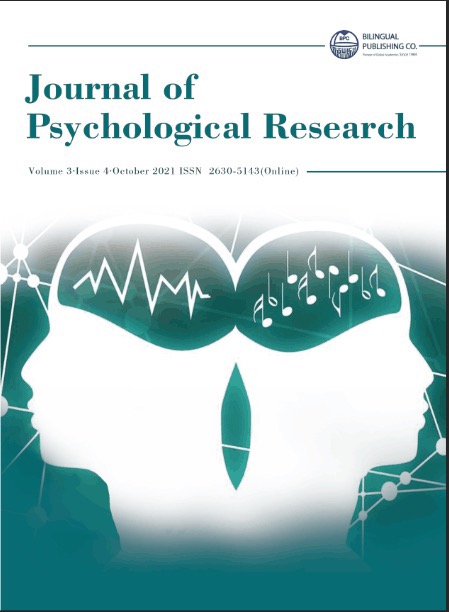-
577
-
554
-
334
-
333
-
324
Strokes of Strength: An Expressive Arts-based Intervention with Adolescents
DOI:
https://doi.org/10.30564/jpr.v3i4.3585Abstract
In order to explore how adolescents who have been affected by traumaticexperiences would respond to an expressive arts-based intervention, amodule was designed, implemented and its effect on certain behavioraland emotional constructs was evaluated. The sample included 10 femaleadolescents between the ages of 12 and 17 who underwent a 2-month longgroup expressive arts therapy in their institutional home, namely, PrayasJuveline Aid Centre, New Delhi, India. The tools which were used toassess the changes in the pre – post intervention scores in self – reportedbehavioral and emotional difficulties were: The Youth Self Report Form(YSR Form 11-18, CBCL; ASEBA, 2001) and the ‘Severity of Post –Traumatic Stress Scale’ (NSESSS; APA, 2013). The tools used to assessthe changes in the pre – post intervention ratings of the caregiver were,the ‘DSM – 5 Parent / Guardian Rated Level 1 Cross Cutting SymptomMeasure’ (APA, 2013) and the ‘Caregiver’s Observation Checklist:Children at – risk’ (WCCL, 2013). The results revealed that 4-weekexpressive arts -based intervention elicited a statistically significantdifference in the self – reported behavioural and emotional difficultiesby the participants. The verbatim reports, diary excerpts and paintings ofthe participants were qualitatively analysed. In future, there is room toinvestigate how an intervention with a longer duration and a representativesample would explain the effectiveness of expressive – arts-based therapywith such populations.Keywords:
Intervention Effectiveness; Trauma; Child Sexual Abuse; Adolescents From Traumatised Backgrounds; Expressive Arts Based TherapyReferences
[1] Browne, K. (2009). The risk of harm to young children in institutional care. London: Save the Children.
[2] Tiwari, V., & Verma, S. (2013). Mental health status of adolescents in relation to perceived parental support. Journal of the Indian Academy of Applied Psychology, 39(2), 213.
[3] Cozolino, L., & Sprokay, S. (2006). Neuroscience and adult learning. New Directions for Adult and Continuing Education, 2006(110), 11-19.
[4] Pifalo, T. (2006). Art therapy with sexually abused children and adolescents: Extended research study. Art Therapy, 23(4), 181-185.
[5] Pies, R. (2008). Summoning the muse: the role of ex-pressive arts therapy in psychiatric care. Psychiatric Times, 25(1), 10-10.
[6] Pearson, M., & Wilson, H. (2001). Sandplay & symbol work: Emotional healing & personal development with children, adolescents, and adults. Sandplay & Symbol Work: Emotional Healing & Personal Development With Children, Adolescents, and Adults, viii.
[7] Eaton, L. G., Doherty, K. L., & Widrick, R. M. (2007). A review of research and methods used to establish art therapy as an effective treatment method for traumatized children. The Arts in Psychotherapy, 34(3), 256-262.
[8] Lyshak-Stelzer, F., Singer, P., Patricia, S. J., & Chemtob, C. M. (2007). Art therapy for adolescents with posttraumatic stress disorder symptoms: A pilot study. Art Therapy, 24(4), 163-169.
[9] Cluver, L. D., Gardner, F., & Operario, D. (2008). Effects of stigma on the mental health of adolescents orphaned by AIDS. Journal of Adolescent Health, 42(4), 410-417.
[10] Van der Kolk, B. (1987). Psychological trauma. Washington, DC: American Psychiatric Press. pg 11.
[11] Levy, F. J. (1988). Dance/Movement Therapy. A Healing Art. AAHPERD Publications, PO Box 704, Waldorf, MD 20601.
[12] Levy, F. J. (Ed.). (2014). Dance and other expressive art therapies: When words are not enough. Routledge.
[13] Griffith, T. (2003). Assisting with the “big hurts, little tears” of the youngest grievers: Working with three-, four-, and five-year-olds who have experienced loss and grief because of death.Illness, Crisis & Loss, 11(3), 217-225.
[14] Malchiodi, C. A. (1999). Medical art therapy with children. Jessica Kingsley Publishers.
[15] Rothschild, B. (2000). The body remembers: The psychophysiology of trauma and trauma treatment. WW Norton & Company.
[16] Vujanovic, A. A., Bonn-Miller, M. O., Potter, C. M., Marshall, E. C., & Zvolensky, M. J. (2011). An evaluation of the relation between distress tolerance and posttraumatic stress within a trauma exposed sample. Journal of psychopathology and behavioral assessment, 33(1), 129-135.
[17] Kalmanowitz, D., & Ho, R. T. (2016). Out of our mind. Art therapy and mindfulness with refugees, political violence and trauma. The Arts in Psychotherapy, 49, 57-65.
[18] Koppitz, E.M. (1966) Emotional indicators on human figure drawings of children: A validitystudy . Journal of Clinical Psychology, 22(3), 313-315.
[19] Clements, P. T., Benasutti, K. M., & Henry, G. C. (2001). Drawing from experience: Using drawings to facilitate communication and understanding with children exposed to sudden traumatic deaths. Journal of psychosocial nursing and mental health services, 39(12), 12-20.
[20] Clements, K. (1996). The use of art therapy with abused children. Clinical Child Psychology and Psychiatry, 1(2), 181-198.
[21] Cohen, F. W., & Phelps, R. E. (1985). Incest markers in children's artwork. The Arts in Psychotherapy, 12(4), 265-283.
[22] Drucker, K. L. (2001). Why can’t she control herself? Art therapy with young survivors of sexual abuse: Lost for words, 101.




 Khwaish Sharma
Khwaish Sharma





